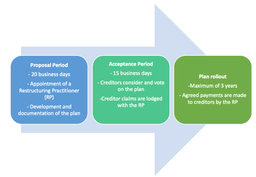How Does The Small Business Restructure Regime Work?
Since its introduction in January 2020, the Small Business Restructure (SBR) regime continues to be underutilised by Australian SME businesses that are in distress. According to ASIC statistics, as of March 2022 only 42 companies had applied to enter into the SBR process with 30 Plans agreed to by creditors. However, this number doubled in the following three months to June 2022 with 40 new companies entering into the SBR process.
We speculate that this low pre-March 2022 number was predominantly due to the lack of creditor pressure (particularly from the ATO during COVID). However with the ATO starting to refill its debt recovery pipeline, many SME’s with COVID hangover debts are now utilising the SBR process to compromise debts owed to their creditors, including ATO debt (core debt, penalties & interest). In addition to compromising the debt owed, it can be used to prevent Insolvent Trading and fend off any potential ATO Director Penalty Notices. We know that the ATO is now sending out 150 Director Penalty Notices per day.
Here’s how the SBR works:
- Directors remain in control of the day-to-day operations
- reduced complexity from other insolvency processes
- reduced cost
- creditor action is halted
- we help the directors prepare the offer to compromise unsecured debts
To qualify for entry into this new regime the company must:
- have creditors totalling less than $1million (excluding employee entitlements)
- not have previously availed itself (or its directors) of the debt restructuring process
- have all of its employee entitlements paid (primarily being superannuation); and
- lodged all of its returns with the ATO
For those that don’t qualify but are still insolvent, the traditional Voluntary Administration and Liquidation pathways remain open.
The three phases of the SBR
As stated, during the SBR the director remains in control of the business and retains the ability to make decisions regarding the business, pays debts incurred in the ordinary course of business after the SBR commences and pays employees.
Creditors can continue to trade with the company during the SBR period and can expect to be paid in accordance with their usual terms.
The SBR process itself is made up of three phases:
- Proposal Period
As the appointed Restructuring Practitioner (RP) our role is to assist directors with developing the plan and put together the required information to be sent to the company’s creditors:
- Restructuring plan;
- Restructuring proposal statement, which includes a list of creditors and the amount they are owed; and
- Voting forms
The RP is required to make reasonable enquiries to verify the company’s business, property, affairs and financial circumstances. It is likely that a comparison of the potential return to creditors under a liquidation versus that which they can expect under the plan will also be provided to creditors.
The restructuring plan also provides for the cost of the RP administering the plan and will be approved by creditors if they accept the plan.
2. Acceptance Period:
Creditors have 15 business days to cast their vote about whether they agree to the proposal. If a majority in value of voting creditors approve the plan, all unsecured creditors are bound. The ATO has stated that of the 36 proposals it received prior to March 2022, it has supported 33.
As employees are not bound by the plan they do not vote. Related Party creditors are also not allowed to vote. Voting forms are returned to the RP together with details of debts claimed.
3. Plan rollout
If the proposal is not accepted then the SBR process ends – the company (while insolvent) is allowed to continue to trade and is not immediately placed into liquidation.
If the plan is accepted, the company is released from all debts and continues its operations with a healthy balance sheet.
The role of the RP is to then:
- receive the contributions from the company under the terms of the plan;
- make payment(s) to creditors based upon their admitted claims; and
- monitor and report on any contraventions of the plan
As you may appreciate, the ability to bind all unsecured creditors (including the ATO) provides the business with the maximum opportunity to turnaround its affairs, save jobs and enable a return to creditors – all while the director remains in control.
If you or your client think you may be a candidate for the SBR process, do not hesitate to make an appointment to speak with one of our partners before creditors take their own action to recover their debt.
